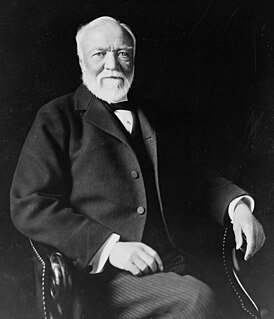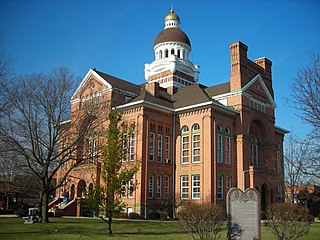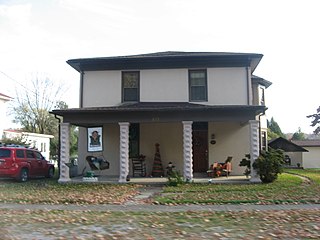Middleport Public Library | |
Front and southern side | |
| Location | 178 S. Third St., Middleport, Ohio |
|---|---|
| Coordinates | 39°0′2″N82°2′59″W / 39.00056°N 82.04972°W Coordinates: 39°0′2″N82°2′59″W / 39.00056°N 82.04972°W |
| Area | Less than 1 acre (0.40 ha) |
| Built | 1912 |
| Architect | Charles P. Kircher |
| NRHP reference # | 86000033 [1] |
| Added to NRHP | January 6, 1986 |
The Middleport Public Library is a historic Carnegie library in the Ohio River village of Middleport, Ohio, United States. Built in the early twentieth century, it has been named a historic site.

A Carnegie library is a library built with money donated by Scottish-American businessman and philanthropist Andrew Carnegie. A total of 2,509 Carnegie libraries were built between 1883 and 1929, including some belonging to public and university library systems. 1,689 were built in the United States, 660 in the United Kingdom and Ireland, 125 in Canada, and others in Australia, South Africa, New Zealand, Serbia, Belgium, France, the Caribbean, Mauritius, Malaysia, and Fiji.

The Ohio River is a 981-mile (1,579 km) long river in the midwestern United States that flows southwesterly from western Pennsylvania south of Lake Erie to its mouth on the Mississippi River at the southern tip of Illinois. It is the second largest river by discharge volume in the United States and the largest tributary by volume of the north-south flowing Mississippi River that divides the eastern from western United States. The river flows through or along the border of six states, and its drainage basin includes parts of 15 states. Through its largest tributary, the Tennessee River, the basin includes several states of the southeastern U.S. It is the source of drinking water for three million people.

Middleport is a village in Meigs County, Ohio, United States, along the Ohio River. The population was 2,530 at the 2010 census.
Middleport was founded as "Sheffield" during the 1820s, a time of great prosperity and rapidly increasing commerce in Meigs County. Among its earliest industries was a cotton mill, built despite the lack of cotton production in the vicinity. [2] Local residents formed the village's first public library in 1908, but its initial location on the second floor of a commercial building soon proved unsatisfactory. One year later, the library's board contacted Andrew Carnegie's Carnegie Corporation in order to begin participating in its library construction program. Negotiations ultimately resulted in the foundation agreeing to provide the village with construction money, and the building was completed in 1912 under the direction of Athens contractor Charles Kirchner. [3]

A public library is a library that is accessible by the general public and is usually funded from public sources, such as taxes. It is operated by librarians and library paraprofessionals, who are also civil servants.

Andrew Carnegie was a Scottish-American industrialist, business magnate, and philanthropist.

Athens is a city and the county seat of Athens County, Ohio, United States. Athens is most widely known as the home of Ohio University, a large public research university with an enrollment of more than 36,800 students across all campuses. Located along the Hocking River in the southeastern part of Ohio about 65 miles (105 km) southeast of Columbus, Athens is the principal city of the Athens, Ohio Micropolitan Statistical Area. The official population of Athens in the 2010 U.S. Census was 23,832, with a daytime population of over 40,000
The Middleport library is a brick building with a tiled roof and a brick foundation. [4] Its architecture is generally simple, although some details of the facade display a Georgian Revival architectural flavor; some of the more ornate examples are the pediment above the portico, the quoins, and the dentils underneath the pediment and the cornice. [3] In January 1986, the library was listed on the National Register of Historic Places. [1] It qualified for inclusion under two different criteria: its architecture, which makes the library Middleport's most distinctive public building, and for its place in local history — besides its status as an example of small-town Carnegie libraries, it remained an icon of Middleport's early twentieth-century community activities. [3] The library is one of three Middleport locations on the National Register, along with the John Downing Jr. House and the William H. Grant House. [1]

In engineering, a foundation is the element of a structure which connects it to the ground, and transfers loads from the structure to the ground. Foundations are generally considered either shallow or deep. Foundation engineering is the application of soil mechanics and rock mechanics in the design of foundation elements of structures.

Georgian architecture is the name given in most English-speaking countries to the set of architectural styles current between 1714 and 1830. It is eponymous for the first four British monarchs of the House of Hanover—George I, George II, George III, and George IV—who reigned in continuous succession from August 1714 to June 1830. The style was revived in the late 19th century in the United States as Colonial Revival architecture and in the early 20th century in Great Britain as Neo-Georgian architecture; in both it is also called Georgian Revival architecture. In the United States the term "Georgian" is generally used to describe all buildings from the period, regardless of style; in Britain it is generally restricted to buildings that are "architectural in intention", and have stylistic characteristics that are typical of the period, though that covers a wide range.

A pediment is an architectural element found particularly in classical, neoclassical and baroque architecture, and its derivatives, consisting of a gable, usually of a triangular shape, placed above the horizontal structure of the entablature, typically supported by columns. The tympanum, the triangular area within the pediment, is often decorated with relief sculpture.
The Middleport library currently is operated as a branch of Meigs County District Public Library system. [5]






















